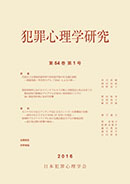
- Issue 2 Pages 1-
- Issue 1 Pages 1-
- |<
- <
- 1
- >
- >|
-
Yuka Oe, Nobuaki Morita, Yoji Nakatani2008Volume 46Issue 2 Pages 1-13
Published: December 31, 2008
Released on J-STAGE: September 30, 2017
JOURNAL FREE ACCESSThis study was an empirical attempt to make a typology of juvenile sex offenders by using the J-SOAP-II (Juvenile Sex Offender Assessment Protocol-II) scales, and to see its applicability to risk assessment of recidivism and treatment planning. Methods: Data was extracted from the archival files of 115 boys who were arrested for any contact sex offense and placed in a Juvenile Classification Home in Japan from 1997 to 2006. Results: Two-step cluster analysis was performed on 4 J-SOAP-II scales, and the subjects were classified into 3 cluster groups: Antisocial-Impulsive, Unsocial-Hypersexual, and Transient/Latent. The differential characteristics of each group were found in comparing the J-SOAP-II scales, personality and so on, and examining recidivism rate of both general and sex offenses. Then, based on these differences among the groups, treatment strategies appropriate for each cluster group were proposed. In conclusion, the typology developed in this study was considered to be useful in clinical and practical settings.
View full abstractDownload PDF (10275K)
-
Yasuyuki Fuchigami2008Volume 46Issue 2 Pages 15-23
Published: December 31, 2008
Released on J-STAGE: September 30, 2017
JOURNAL FREE ACCESSDownload PDF (6032K) -
Fumio Saito2008Volume 46Issue 2 Pages 25-38
Published: December 31, 2008
Released on J-STAGE: September 30, 2017
JOURNAL FREE ACCESSThe present study employed the use of the Murray's Thematic Apperception Test (TAT) in order to examine the characteristics of personality and psychodynamics of pareiticides. The subjects were nine parenticides, who were all male, ranging in age from teenage through middle age with the average age of 26 yrs. and ranging in IQ from “borderline” through “superior” with the average IQ of 94. These nine cases were divided into two groups; namely, the junior group (N=4) who were 21 yrs. of age or younger, and the senior group (N=5) who were 26 yrs. of age or older. For the purpose of examination of their primitive aggression, attention was focused on (1) fantasies of supernatural beings and their magical, miraculous and mysterious powers, (2) fantasies of natural/physical distractive powers, and (3) fantasies of animals, especially of wild animals. The findings were the following. (1) Three of the four junior parenticides and two of the five senior parenticides produced TAT stories, in which supernatural beings such as god, evil spirit and vengeful ghost were introduced and their magical/mysterious powers were mentioned. These fantasies were interpreted to indicate their infantile illusion of omnipotence and weakness of reality testing. (2) All of the nine parenticides produced TAT stories, in which mentioned were natural distractive powers such as storm, flood, landslide, earthquake and heavy snow, and/or physical distractive powers such as accidental discharge of firearms, downfall, collision, explosion and fire. These fantasies were interpreted to indicate their primitive and impulsive tendency of acting-out and insufficient control of ego. (3) Eight of the nine parenticides produced TAT stories, in which various animals, mostly wild animals were mentioned and/or introduced, such as birds, dragons, tigers, and poisonous animals. These fantasies of animals were interpreted to indicate their immature personality. With regard to their self-images, the following were discussed. (1) One of the junior parenticides expressed mainly helpless and poor self-image, but other three junior parenticides expressed many inconsistent, unstable and/or bizarre self-images. These fantasies were interpreted to indicate that they employed various primitive defense mechanisms such as primitive idealization, devaluation, and ego-splitting. It was presumed that their personality was similar to the so-called borderline personality structure. (2) On the contrary, all of the senior parenticides expressed almost solely helpless, devaluated and negative self-images in their TAT narratives. Three of them imagined commitment of suicide on Card 3BM. These fantasies were interpreted to indicate that they had poor self-esteem and destructive aggression towards themselves.
View full abstractDownload PDF (10956K) -
Kohske Ogata2008Volume 46Issue 2 Pages 39-47
Published: December 31, 2008
Released on J-STAGE: September 30, 2017
JOURNAL FREE ACCESSThe aim of this study was to investigate the Wechsler Intelligence Scale for Children third edition (WISC-III) subtest profile of delinquent children. The participants were 384 children (190 delinquent and 194 comparison) extracted from the case records in Child Guidance Centers (CGC). MANOVA detected the significant difference on the WISC-III subtests profile between delinquent group and comparison group. All of Bonferroni corrected t-test, discriminant function analysis, and logistic regression analysis consistently demonstrated the significant association between delinquency and the information, which is a subtest of WISC-III. Findings suggested that the information, through the school achievement reported in previous studies, may related to delinquency indirectly. Furthermore, implication for clinical practices in CGC were discussed.
View full abstractDownload PDF (6435K)
- |<
- <
- 1
- >
- >|